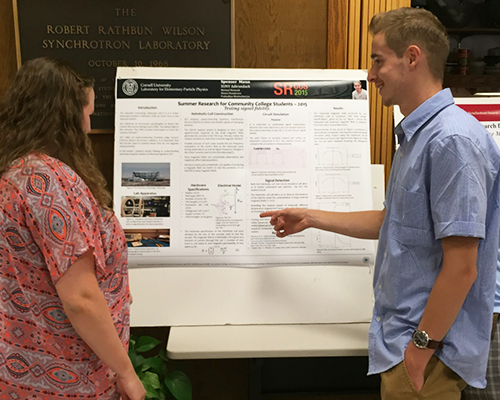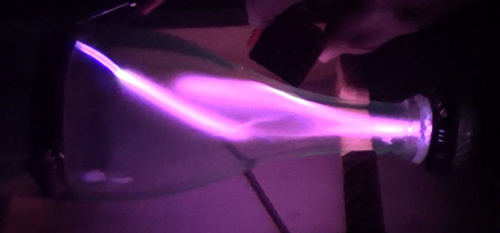X-RAY RUNS: Apply for Beamtime
2017 Nov 1 - Dec 21
2018 Feb 7 - Apr 3
2018 Proposal/BTR deadline: 12/1/17
2018 Apr 11 - Jun 4
2018 Proposal/BTR deadline: 2/1/18
An important part of the mission of CHESS as a national user facility is its role training the next generation of students to fill roles in the varied fields in science, technology, engineering and math – the so-called STEM fields. The current CHESS award supports undergraduate students through both formal and informal programs. One of our newest efforts is a summer program for upstate community college students is named “Summer Research for Community College Students”, or SRCCS, and is modeled after the very successful REU program supported by NSF. Under this program, four to five students interested in STEM careers are invited to participate in cutting-edge research at the CLASSE. During the eight-week program, in addition to participation in accelerator and x-ray sciences research, the program include formal seminars, lectures, tours of research facilities, social and recreational events, building exhibits for the lab’s outreach program, and a forum at the program's end during which participants presented results of their research. Participants also enjoy a stipend and local group housing on the Cornell University campus.
Participants in the SRCSS program are assigned a mentor to define the nature of the research project, to guide the participant's effort through frequent interaction, and to provide one-on-one training. Our hope is that mentors are also able to advice on potential college and career options in the physical sciences, and stay in contact with participants after the summer research program. Good communication skills are essential for successful carriers in science, technology, and nearly all other fields. To practice these, SRCCS participants give presentations, created short videos documenting their role in the assigned research project, and discuss the exciting results of their summer research during a final poster session at the end of the summer.
This past year Spenser Mann, from SUNY Adirondack, worked to help develop superconducting devices that will be used to measure the cosmic microwave background — the oldest light in the universe. The research was supervised by Prof. Michael Niemack and Dr. Shawn Henderson, who are part of a larger collaboration doing R&D at the Atacama Cosmology Telescope (ACT), a 6 meter telescope located in Northern Chile on Cerro Toco in the Atacama Desert. Spenser worked to understand and improve the readout of electrical signals in ACT, designing and building a Helmholtz coil capable of producing a magnetic field 20X Earth’s to test the sensitivity of ACT detectors to stray magnetic fields.

Spenser Mann describing his work using his SRCCS final poster.
Jeffrey Branigan, from Mohawk Valley Community College, worked on the electronic design, prototyping and testing of cryogenic temperature sensors. He was part of a team of mentors including John Dobbins, Eric Smith and Peter Quigley, all expert electrical and cryogenics engineers in CLASSE. He analyzed capabilities and drawbacks of both home built and commercial products, helping the team refine a set of specifications, circuit design and prototyping, and testing. Among other critical uses, these sensors are ultimately part of diagnostic equipment needed to characterize the perfection and performance of superconducting radio-frequency cavities used to power the storage ring at Cornell (and at many other facilities).
Aaron Lusby, from Mohawk Valley Community College, work with mentoring staff engineer Karl Smolenski on a project exploring the history of and then building a replica of antique electron gun vacuum tubes (Geissler tubes, Crooks tubes, etc.). His engineering challenge was to put together a vacuum tube and rudimentary high voltage supply to simulate, or realize, the success of the tubes first invented almost 150 years ago. Although some engineering feats (like fixed tubes with no vacuum pumps) were hard to achieve, he did manage to build a working tube with dramatic visual flare. With some refinements our outreach group is hoping it can be used as highly visual and potentially interactive science exhibits and demonstration.

Crookes tube built by Aaron Lusby, demonstrating how and electron beam in vacuum can be deflected by and external permanent magnet (held at top).
Last but certainly not least, Devin Sonne from Mohawk Valley Community College worked both our scientific and education staff to develop an activity for high school educators. She worked to update our x-ray florescence technology display and took on the challenge to find new ways to transfer the knowledge gained from the research conducted at the laboratory to students in high school chemistry, physics, and biology classrooms. See the accompanying article in this newsletter for details: http://news.chess.cornell.edu/articles/2015/Hine150911.html
Submitted by: Ernest Fontes, CHESS, Cornell University
09/14/2015
